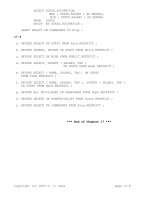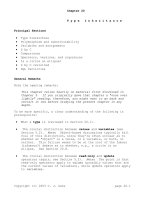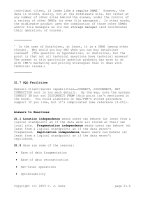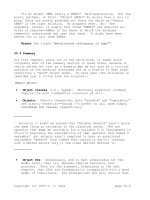RADIATION PROTECTION MANUAL Episode 2 pot
Bạn đang xem bản rút gọn của tài liệu. Xem và tải ngay bản đầy đủ của tài liệu tại đây (41.16 KB, 15 trang )
EM 385-1-80
30 May 97
2-7
also directly supervise
Authorized Users Assistants
working with radioactive
material. All AUs must be
approved by the facility RPC,
if one exists. If the facility
does not require an RPC, the
AUs must be approved by the
RPO. All AUs must meet the
following training and
experience requirements:
a. A working knowledge of
applicable regulations
pertaining to radioactive
material, radiation generating
devices, and radioactive and
mixed waste with which they may
be working;
b. Unless different
requirements are stated in the
license, authorization or
permit conditions, eight clock
hours of formal training
covering:
(1) the physics of
radiation, radiation's
interaction with matter, and
the mathematics necessary to
understand the above subjects;
(2) the biological
effects of radiation;
(3) the instrumentation
necessary to detect, monitor,
and survey radiation, and the
use of such instrumentation;
and
(4) radiation safety
techniques and procedures.
This training will include the
use of time, distance,
shielding, engineering
controls, and PPE to reduce
exposure to radiation.
c. Practical, hands-on
experience using radiation
instrumentation and procedures.
The level of training will be
commensurate with the hazard
presented by the radioactive
material or radiation
generating device; and
d. A working knowledge of
the USACE and his or her USACE
Command Radiation Protection
Program, and the record keeping
requirements for the
radioactive material and
radiation generating devices
used in their work.
e. Instruction in their
rights and their
responsibilities under the
USACE Command NRC license, or
Army Radiation Authorization
(ARA). This includes:
(1) the employer’s duty to
provide safe working
conditions;
(2) a report of all
radiation exposure to the
individual;
(3) the individual's
responsibility to adhere to the
NRC’s regulations and the
Commands's radiation material
license, or ARA; and
(4) the individual's
EM 385-1-80
30 May 97
2-8
responsibility to report any
violation or other occurrence
to the RPO.
f. Authorized users of
portable gauges will also
receive 8 hours training in the
safety and use of the gauge
from the manufacturer.
2-8. Authorized Users’
Assistants (AUAs).
AUAs are individuals allowed to
work with radioactive material
only under the direct
supervision of an AU (that is,
in the physical presence of the
AU). All AUAs must be
nominated by the AU and
approved by the RPO. AUAs will
have the training and
experience described below:
a. A total of at least
four hours instruction in the
following:
(1) the health effects
associated with exposure to the
radioactive material or
radiation they work with;
(2) ways to minimize
exposure;
(3) the purpose and use of
protective equipment used in
their work; and
(4) the applicable
regulations to their work.
b. Practical, hands-on
experience using radiation
instrumentation and procedures.
c. Instruction in their
rights and their
responsibilities under the
USACE Command NRC license, or
ARA. This includes:
(1) the employer’s duty to
provide safe working
conditions;
(2) a report of all
radiation exposure to the
individual;
(3) the individual's
responsibility to adhere to the
NRC’s regulations and the
Command's radioactive material
license, or ARA; and
(4) the individual's
responsibility to report any
violation or other occurrence
to the RPO.
2-9. Site Supervisors/
Construction Quality Assurance
Personnel.
a. Individuals working as
site supervisors or
construction quality assurance
representatives on projects
involving radioactive material
or radiation generating devices
must be knowledgeable of: the
principles of radiation
protection; applicable
regulations pertaining to
radioactive material and
radiation generating devices,
and the application of these
principles and regulations to
worker and public health and
safety at project sites.
EM 385-1-80
30 May 97
2-9
b. Individuals who
supervise work or act as
construction quality assurance
representatives at sites
involving radioactive material
or radiation generating devices
will have a minimum of eight
hours of radiation safety
training covering the
following:
(1) physics of radiation,
radiation's interaction with
matter, and the mathematics
necessary to understand the
above subjects;
(2) biological effects of
radiation;
(3) instrumentation
necessary to detect, monitor,
and survey radiation, and the
use of such instrumentation;
and
(4) radiation safety
techniques and procedures.
This training will include the
use of time, distance,
shielding, engineering
controls, and PPE to reduce
exposure to radiation.
2-10. Project/Plan/Procedure
Originators and Reviewers.
a. Individuals who
originate or review projects,
plans, or procedures involving
radioactive material or
radiation generating devices
must be knowledgeable of the
principles of radiation
protection, the applicable
regulations pertaining to
radioactive material and
radiation generating devices,
and the application of these
principles and regulations to
worker and public health and
safety.
b. Originators and
reviewers of plans, projects or
procedures for work at sites
using radioactive material or
radiation generating devices
will have a minimum of eight
hours of radiation safety
training covering the
following:
(1) physics of radiation,
radiation's interaction with
matter, and the mathematics
necessary to understand the
above subjects;
(2) biological effects of
radiation;
(3) instrumentation
necessary to detect, monitor,
and survey radiation, and the
use of such instrumentation;
and
(4) radiation safety
techniques and procedures.
This training will include the
use of time, distance,
shielding, engineering
controls, and PPE to reduce
exposure to radiation.
2-11. Radiation Protection
Committee (RPC).
a. Each Command possessing
an NRC license or an ARA with a
EM 385-1-80
30 May 97
2-10
condition stating that the
licensee shall have an RPC, or
where the Commander deems
necessary, shall form an RPC.
At a minimum, the RPC will
consist of:
(1) The Commanding Officer
(CO) or deputy;
(2) The RPO, who will act
as recorder for all meetings;
(3) The Chief; Safety and
Occupational Health Office; and
(4) A representative
Authorized User from each group
using radioactive material or
radiation generating devices in
the Command.
b. The RPC is accountable
to its USACE Commander. The CO
or his/her deputy chairs the
RPC. The RPC will meet at least
once each six-month period and
at the call of the chair. The
RPC will continually evaluate
radiological work activities,
and make recommendations to the
RPO and management. In
addition to its
responsibilities established
in the Army Radiation
Protection Program, the RPC
responsibilities
include:
(1) Annual review of USACE
Command personnel exposure
records;
(2) Establishing criteria
for determining the appropriate
level of review and
authorization for work
involving radiation exposure;
and,
(3) Evaluating health and
safety aspects of the
construction and design of
facilities and systems and
planned major modifications or
work activities involving
radioactive material or
radiation generating devices.
c. The RPO will furnish
the installation commander and
RPSO with copies of the
minutes of all RPC meetings,
within 30 days of the meeting.
2-12. Hazardous, Toxic and
Radioactive Waste (HTRW),
Center of Expertise (CX).
a. The HTRW-CX provides
technical assistance to USACE
headquarters, and design
districts as requested on all
areas of HTRW and environmental
remediation. The CX has a staff
that includes Technical Liaison
Managers (TLMs), Chemists,
Regulatory Specialists,
Geotechnical, Process, and Cost
Engineers, Risk Assessment,
Industrial Hygiene and Health
Physics personnel.
b. The HTRW-CX can provide
technical assistance to the
RPSO as requested, including:
(1) licensing,
(2) inspecting,
(3) product development,
EM 385-1-80
30 May 97
2-11
(4) and advice and
guidance on radiation safety
and protection issues.
c. The HTRW-CX can provide
support to other Commands on
radiation safety issues,
including radon, X-ray
fluorescence devices for lead
monitoring, etc.
2-13. Refresher Training.
USACE personnel who have
completed their initial
training, shall receive annual
refresher training on the
material described for each
person in this chapter. The
refresher training may be
comprised of an update of SOPs,
review of dosimetry results,
changes in standards or
guidance, equipment changes,
and any other pertinent
radiation safety information
that needs review. The length
of this training is dependent
on the specific material being
covered, it does not have to
equal the time requirements
needed for initial training.
Personnel who have completed
their initial training and any
subsequent refresher training,
but currently are not and will
not be assigned to work
involving radiation, are not
required to be up-to-date
regarding the refresher
training requirement.
Personnel whose refresher
training has lapsed may not
work with radiation until after
completion of refresher
training. Personnel who have
not received refresher training
for over two years may be
required, at the RPO’s
discretion, to repeat their
initial training.
2-14. Additional Training -
Special Applications.
Additional training may be
required for work involving
special applications (for
example
,
plutonium, fissile
uranium, tritium, and accelera-
tor facilities). Personnel
working with special
applications should consult
with the HTRW-CX for additional
training requirements.
2-15. All Personnel including
Visitors, at a Radiation Site.
a. Regulations require
that all individuals who are
likely to receive 100 mrem
above background in one year
shall be kept informed of the
presence of radioactive
material or radiation in the
area and shall be instructed
annually in the following:
(1) The health effects
associated with exposure to the
radioactive material or
radiation;
(2) Ways to minimize
exposure;
(3) The purpose and use of
protective equipment and survey
instruments used in the area;
EM 385-1-80
30 May 97
2-12
(4) The regulations
applicable to the area.
b. The extent of
instruction shall be
commensurate with the extent of
the hazard in the area.
EM 385-1-80
30 May 97
3-1
Chapter 3. Introduction to
Radiation.
3-1. Atomic Structure.
a. The atom, which has
been referred to as the
"fundamental building block of
matter," is itself composed of
three primary particles: the
proton, the neutron, and the
electron. Protons and neutrons
are relatively massive compared
to electrons and occupy the
dense core of the atom known as
the nucleus. Protons are
positively charged while
neutrons are neutral. The
negatively charged electrons
are found in a cloud
surrounding the nucleus.
b. The number of protons
within the nucleus defines the
atomic number, designated by
the symbol Z. In an
electrically neutral atom (that
is, one with equal numbers of
protons and electrons), Z also
indicates the number of
electrons within the atom. The
number of protons plus neutrons
in the nucleus is termed the
atomic mass, symbol A.
c. The atomic number of an
atom designates its specific
elemental identity. For
example, an atom with a Z=l is
hydrogen, an atom with Z=2 is
helium, and Z=3 identifies an
atom of lithium. Atoms
characterized by a particular
atomic number and atomic mass
are called nuclides. A
specific nuclide is represented
by its chemical symbol with the
atomic mass in a superscript
(for example, H, C, U) or
3 14 238
by spelling out the chemical
symbol and using a dash to
indicate atomic mass (for
example, radium-222, uranium-
238). Nuclides with the same
number of protons (that is,
same Z) but different number of
neutrons (that is, different A)
are called isotopes. Isotopes
of a particular element have
nearly identical chemical
properties, but may have vastly
different radiological
properties.
3-2. Radioactive Decay.
a. Depending upon the
ratio of neutrons to protons
within its nucleus, an isotope
of a particular element may be
stable or unstable. Over time,
the nuclei of unstable isotopes
spontaneously disintegrate or
transform in a process known as
radioactive decay or
radioactivity. As part of this
process, various types of
ionizing radiation may be
emitted from the nucleus.
Nuclides which undergo
radioactive decay are called
radionuclides. This is a
general term as opposed to the
term radioisotope which is used
to describe an isotopic
relationship. For example, H,
3
C, and I are radionuclides.
14 125
Tritium ( H), on the other
3
hand, is a radioisotope of
hydrogen.
EM 385-1-80
30 May 97
3-2
b. Many radionuclides such
as radium-226, potassium-40,
thorium-232 and uranium-238
occur naturally in the
environment while others such
as phosphorus-32 or sodium-22
are primarily produced in
nuclear reactors or particle
accelerators. Any material
which contains measurable
amounts of one or more
radionuclides is referred to as
a radioactive material. As any
handful of soil or plant
material will contain some
measurable amount of
radionuclides, we must
distinguish between background
radioactive materials and man-
made or enhanced concentrations
of radioactive materials.
c. Uranium, thorium and
their progeny, including radium
and radon are Naturally
Occurring Radioactive Materials
(NORM). Along with an isotope
of potassium (K-40) these make
up the majority of NORM
materials and are found in most
all soil and water, and are
even found in significant
quantities within the human
body.
d. Another group of
radionuclides are referred to
as transuranics. These are
merely elements with Z numbers
greater than that of uranium
(92). All transuranics are
radioactive. Transuranics are
produced in spent fuel
reprocessing facilities and
nuclear weapons detonations.
3-3. Activity.
a. The quantity which
expresses the degree of
radioactivity or radiation
producing potential of a given
amount of radioactive material
is activity. The activity may
be considered the rate at which
a number of atoms of a material
disintegrate, or transform from
one isotope to another which is
accompanied by the emission of
radiation. The most commonly
used unit of activity is the
curie (Ci) which was originally
defined as that amount of any
radioactive material which
disintegrates at the same rate
as one gram of pure radium.
That is, 3.7 x 10
10
disintegrations per second
(dps). A millicurie (mCi) =
3.7 x 10 dps. A microcurie
7
(µCi) = 3.7 x 10 dps. A
4
picocurie (pCi) = 3.7 x 10
-2
dps.
b. The Systeme
Internationale (SI) unit of
activity is the becquerel (Bq)
which equals 1 dps. Systeme
Internationale units, such as
meters and grams, are in use
throughout the rest of the
world. Only the United States
still uses units of curies for
activity.
c. The activity of a given
amount of radioactive material
is not directly related to the
mass of the material. For
example, two one-curie sources
containing cesium-137 might
EM 385-1-80
30 May 97
3-3
have very different masses,
depending upon the relative
proportion of non-radioactive
atoms present in each source.
for example, 1 curie of pure
cesium-137 would weigh 87
grams, and 50 billion kilograms
(100 million tons) of seawater
would contain about 1 curie of
Cs-137 from fallout.
3-4. Decay Law.
a. The rate at which a
quantity of radioactive
material decays is proportional
to the number of radioactive
atoms present. This can be
expressed by the equation
(Eq.):
N=N e Eq. 1
o
-þt
Where N equals the number of
atoms present at time t, N is
o
the initial number of
radioactive atoms present at
time 0, þ is the decay constant
for the radionuclide present,
(this can be calculated from
the half-life of the material
as shown below),and e is the
base of the natural logarithms.
Table 3-1 indicates half-lives
and other characteristics of
several common radionuclides.
b. Since activity A is
proportional to N, the equation
is often expressed as:
A = A e Eq. 2
o
-þt
Table 3-1. Characteristics of Selected Radionuclides
Radionuclide Half-life (Type and max. energy in MeV)
hydrogen-3 12.3 years þ, 0.0186
carbon-14 5370 years þ, 0.155
phosphorus-32 14.3 days þ, 1.71
sulfur-35 87.2 days þ, 0.167
potassium-40 1.3E09 years þ, 1.310
iodine-125 59.7 days þ/X, 0.035
cesium-137 30.2 years þ/X, 0.51/.662
thorium-232 1.4E10 years þ/X, 4.081
uranium-238 4.4E09 years þ/X, 4.147
americium-241 432 years þ/X, 5.49/.059
þ-alpha particle, þ-beta particle, X-gamma or X-ray
c. Half-life. When half
of the radioactive atoms in a
given quantity of radioactive
material have decayed, the
activity is also decreased by
half. The time required for the
activity of a quantity of a
particular radionuclide to
decrease to half its original
value is called the half-life
EM 385-1-80
30 May 97
3-4
Eq. 3
(T ) for the radionuclide.
1/2
d. It can be shown
mathematically that the
half-life (T ) of a particular
1/2
radionuclide is related to the
decay constant (þ) as follows:
Substituting this value of þ
into Equation 2, one gets:
e. Example 1: You have 5
mCi of phosphorus-32 (T =
1/2
14.3 days). How much activity
will remain after 10 days?
A = ?
A = 5 mCi
o
t = 10 d
þ = .693
14.3 d
A = A e
o
-þt
A = 3.1 mCi
f. An alternative method
of determining the activity of
a radionuclide remaining after
a given time is through the use
of the equation:
f = (½) Eq. 4
n
where f equals the fraction of
the initial activity remaining
after time t and n equals the
number of half-lives which have
elapsed. In Example 1 above,
n = t/T
1/2
n = 10/14.3
= 0.69
f = (½)
0.69
= 0.62
A = fA
o
= (0.62)(5)
= 3.10 mCi
Both methods may be used to
calculate activities at a prior
date, that is "t" in the
equations may be negative.
g. The activity of any
radionuclide is reduced to less
than 1% after 7 half-lives and
less than 0.1% after 10 half-
lives.
3-5. Types of Ionizing
Radiation.
a. Ionizing radiation may
be electromagnetic or may
EM 385-1-80
30 May 97
3-5
consist of high speed subatomic
particles of various masses and
charges.
(1) Alpha Particles.
Certain radionuclides of high
atomic mass (for example,,
Ra-226, U-238, Pu-239) decay by
the emission of alpha
particles. These are tightly
bound units of two neutrons and
two protons each (a helium
nucleus). Emission of an alpha
particle results in a decrease
of two units of atomic number
(Z) and four units of atomic
mass (A). Alpha particles are
emitted with discrete energies
characteristic of the
particular transformation from
which they originate.
(2) Beta Particles.
A nucleus with a slightly
unstable ratio of neutrons to
protons may decay by changing a
neutron into a proton, or a
proton into a neutron through
the emission of either a high
speed electron or positron
called a beta particle. This
results in a net change of one
unit of atomic number (Z), up
one for a beta minus and down
one for a beta plus. The beta
particles emitted by a specific
radionuclide range in energy
from near zero to up to a
maximum value characteristic of
the particular transformation.
(3) Gamma-rays.
(a) A nucleus which has
disintegrated is left in an
excited state with more energy
than it can contain. This
excited nucleus may emit one or
more photons (that is,
particles of electromagnetic
radiation) of discrete energies
to rid itself of this energy.
The emission of these gamma-
rays does not alter the number
of protons or neutrons in the
nucleus but instead has the
effect of moving the nucleus
from a higher to a lower energy
state. Gamma-ray emission
frequently follows beta decay,
alpha decay, and other nuclear
decay processes.
(b) X-rays and gamma-rays
are electromagnetic radiation,
as is visible light. The
frequencies of X- and gamma
rays are much higher than that
of visible light and so each
carries much more energy.
Gamma- and X-rays cannot be
completely shielded. They can
be attenuated by shielding but
not stopped completely. A gamma
emitting nuclide may yield
multiple gamma- and X-rays,
each with its own discrete
energy. It is possible to
identify a gamma emitting
nuclide by its spectrum.
(4) X-rays.
X-rays are also part of the
electromagnetic spectrum and
are indistinguishable from
EM 385-1-80
30 May 97
3-6
gamma-rays. The only
difference is their source
(that is, orbital electrons
rather than the nucleus). X-
rays are emitted with discrete
energies by electrons as they
shift orbits and lose energy
following certain types of
nuclear excitement or decay
processes.
(5) Bremsstrahlung
radiation.
When a charged particle passes
near the nucleus of an atom,
it deviates from its original
path and is slowed down by the
coulombic interaction with the
nucleus. When this occurs, the
charged particle will emit a
photon to balance the energy.
These photons are called
bremsstrahlung radiation.
Bremsstrahlung radiation only
becomes a significant source of
exposure from high energy beta
particles. The amount of
bremsstrahlung radiation
emitted is proportional to the
Z number of the nucleus the
beta interacted with, and the
energy of the beta particle.
(6) Neutrons.
(a) Neutrons are uncharged
particles released during
fission of heavy atoms
(uranium) or released from some
non-radioactive material after
bombardment by alpha particles
(americium-beryllium [Am-Be]
sources). Because neutrons are
uncharged particles, they
travel further in matter. When
neutrons are sufficiently
slowed down in matter
(thermalized) they are absorbed
by matter with an accompanying
burst of gamma radiation. The
nature of production of the
neutron determines whether it
is emitted in a spectrum (as in
fission) or at a discrete
energy (as from Am-Be sources).
(b) A single radioactive
decay event may generate a
large number of radiations as
illustrated in Table 3-2, for
example:
Table 3-2
I-125 Radiations
RADIATION ENERGY(keV) DECAY%
Gamma 35 6.7
Ka X-ray 27.4 114
Kb X-ray 31 25.6
L X-ray 3.9 12
K Conv.
Elec. 3.7 80
L Conv.
Elec. 31 11.8
M+ Conv.
Elec. 35 2.5
K Auger
Elec. 23 20
L Auger
Elec. 3-4 160
KeV: kiloelectron volt
3-6. Interaction of Radiation
With Matter.
a. Excitation/Ionization.
The various types of radiation
(for example, alpha particles,
EM 385-1-80
30 May 97
3-7
beta particles, and gamma-
rays) impart their energy to
matter primarily through
excitation and ionization of
orbital electrons. The term
"excitation" is used to
describe an interaction where
electrons acquire energy from a
passing charged particle but
are not removed completely from
their atom. Excited electrons
may subsequently emit energy in
the form of X-rays during the
process of returning to a lower
energy state. The term
"ionization" refers to the
complete removal of an electron
from an atom following the
transfer of energy from a
passing charged particle. Any
type of radiation having
sufficient energy to cause
ionization is referred to as
ionizing radiation. In
describing the intensity of
ionization, the term "specific
ionization" is often used.
This is defined as the number
of ion pairs formed per unit
path length for a given type of
radiation.
b. Characteristics of
Different Types of Ionizing
Radiation.
(1) Alpha particles have a
high specific ionization and a
relatively short range. Alpha
particles are massive and carry
a double positive charge. This
combination allows alpha
particles to carry a large
amount of energy but to easily
transfer that energy and be
stopped. In air, alpha
particles travel only a few
centimeters, while in tissue,
only fractions of a millimeter.
For example, an alpha particle
cannot penetrate the dead cell
layer of human skin.
(2) Beta particles have a
much lower specific ionization
than alpha particles and a
considerably longer range. The
relatively energetic beta's
from P-32 have a range of 6
meters in air or 8 millimeters
in tissue. The low-energy
beta's from H-3, on the other
hand, are stopped by only 6
millimeters of air or 5
micrometers of tissue.
(3) Gamma- and X-rays are
referred to as indirectly
ionizing radiation since,
having no charge, they do not
directly apply impulses to
orbital electrons as do alpha
and beta particles. A gamma-
ray or X-ray instead proceeds
through matter until it
undergoes a chance interaction
with a particle. If the
particle is an electron, it may
receive enough energy to be
ionized whereupon it causes
further ionization by direct
interactions with other
electrons. The net result is
that indirectly ionizing
particles liberate directly
ionizing particles deep inside
a medium, much deeper than the
directly ionizing particles
could reach from the outside.
Because gamma rays and X-rays
EM 385-1-80
30 May 97
3-8
undergo only chance encounters
with matter, they do not have a
finite range. In other words,
a given gamma ray has a
definite probability of passing
through any medium of any
depth.
(4) Neutrons are also
indirectly ionizing. When
striking massive particles
such as the nuclei of atoms,
the neutron undergoes elastic
scattering losing very little
energy to the target nucleus.
But when a neutron strikes an
hydrogen nuclei (a single
proton, about the same mass as
a neutron) the energy is shared
nearly equally between the
neutron and the proton
resulting in a loss of about
half of the neutron's energy
before the interaction. The
proton now is a charged,
directly ionizing particle
moving through matter until all
of its energy is transferred to
the matter.
3-7. Human Health Effects.
The effects of ionizing
radiation described at the
level of the human organism can
be divided broadly into two
categories: stochastic (effects
that occur by chance) or
deterministic (non-stochastic)
effects (characterized by a
threshold dose below which
effects do not occur).
a. Stochastic Effects.
Stochastic effects are those
that occur by chance.
Stochastic effects caused by
ionizing radiation consist
primarily of genetic effects
and cancer. As the dose to an
individual increases, the
probability that cancer or a
genetic effect will occur also
increases. However, at no
time, even for high doses, is
it certain that cancer or
genetic damage will result.
Similarly, for stochastic
effects, there is no threshold
dose below which it is
relatively certain that an
adverse effect cannot occur.
In addition, because stochastic
effects can occur in unexposed
individuals, one can never be
certain that the occurrence of
cancer or genetic damage in an
exposed individual is due to
radiation.
b. Deterministic
(Non-Stochastic) Effects.
(1) Unlike stochastic
effects, deterministic effects
are characterized by a
threshold dose below which they
do not occur. In addition, the
magnitude of the effect is
directly proportional to the
size of the dose. Furthermore,
for deterministic effects,
there is a clear causal
relationship between radiation
exposure and the effect.
Examples of deterministic
effects include sterility,
erythema (skin reddening), and
cataract formation. Each of
EM 385-1-80
30 May 97
3-9
these effects differs from the
other in both its threshold
dose and in the time over which
this dose must be received to
cause the effect (that is acute
vs. chronic exposure).
(2) The range of
deterministic effects resulting
from an acute exposure to
radiation is collectively
termed "radiation syndrome."
This syndrome may be subdivided
as follows:
(a) hemopoietic syndrome -
characterized by depression or
destruction of bone marrow
activity with resultant anemia
and susceptibility to infection
(whole body dose of about 200
rads);
(b) gastrointestinal
syndrome - characterized by
destruction of the intestinal
epithelium with resultant
nausea, vomiting, and diarrhea
(whole body dose of about 1000
rads); and
(c) central nervous system
syndrome - direct damage to
nervous system with loss of
consciousness within minutes
(whole body doses in excess of
2000 rads).
(3) The LD (that is, dose
5O
that would cause death in half
of the exposed population) for
acute whole body exposure to
radiation in humans is about
450 rads.
3-8. Determinants of Dose.
The effect of ionizing
radiation upon humans or other
organisms is directly dependent
upon the size of the dose
received and the rate at which
the dose is received (for
example, 100 mrem in an hour
versus 100 mrem in a year).
The dose, in turn, is dependent
upon a number of factors
including the strength of the
source, the distance from the
source to the affected tissue,
and the time over which the
tissue is irradiated. The
manner in which these factors
operate to determine the dose
from a given exposure differs
significantly for exposures
which are "external" (that is,
resulting from a radiation
source located outside the
body) and those which are
"internal" (that is, resulting
from a radiation source located
within the body).
a. External Exposures.
(1) Exposure to sources of
radiation located outside the
body are of concern primarily
for sources emitting gamma-
rays, X-rays, or high energy
beta particles. External
exposures from radioactive
sources which emit alpha or
beta particles with energies
less than 70 keV are not
significant since these
radiations do not penetrate the
dead outer cell layer of the
skin.









